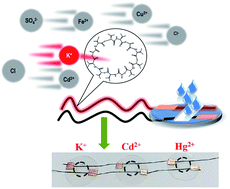Scalable approach towards specific and ultrasensitive cation sensing under harsh environmental conditions by engineering the analyte–transducer interface†
Abstract
Affordable and high-performing sensing platforms are becoming increasingly critical for sustainable environmental monitoring and medical diagnostics. Such miniaturized and point-of-care sensing platforms need to overcome the fundamental tradeoff between ultrahigh sensitivity and specificity while retaining the dynamic concentration range and robustness of operation. Therefore, designing scalable and robust sensors poses an escalating and immediate demand in a rapidly automated society. Addressing this demand, we demonstrate a cable-type electrochemical sensing platform exhibiting rapid (10 s), extremely reliable (RSD <5%) and ultrahigh sensitivity (ppb levels) towards K+, Cd2+ and Hg2+ found in complex biofluids such as human perspiration and effluent water. The sensor delivers quantifiable performance even with 10 μL of analyte without any requirement of purification or preconcentration and thereby overcomes an important bottleneck for on-field diagnostics. The backbone of the sensor consists of single-walled carbon nanotubes (CNTs) that are conformally coated on affordable cellulose yarns to form ideally non-Faradaic, electrically conductive, capacitive electrodes (CNT-thread). Subsequent coaxial coating of such CNT-threads with an appropriate ionophore membrane (IM) realizes the working electrode exhibiting uniformity in the surface coverage of the ionophore leading to reliable and directly quantifiable signals. Furthermore, we show that the extensive CNT-thread–IM interface is critical to achieve ultrahigh sensitivity and robust operability. Importantly, the design approach adopted is universal and scalable for a range of cations such as K+, Hg2+ and Cd2+. Thus, the sensor delivers ultrasensitive detection of K+ from very low volumes (10 μL) of human perspiration that contains a wide range of other ions (Cu2+, Zn2+, Cd2+, Fe2+, NO3−, Cl−) at 1000-fold higher ionic strength along with bioinorganic suspended matter (dead cells, organelles). This eliminates any sample treatment or preconcentration requirements thereby overcoming a major obstacle for point-of-care applications. Furthermore, both multicomponent and multivariate analyses are demonstrated with the sensing device targeting portable and wearable applications.



 Please wait while we load your content...
Please wait while we load your content...